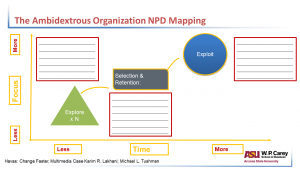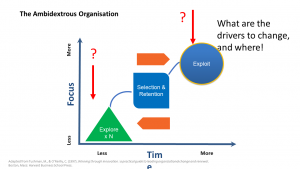6 Ambidexterity and the Congruence Model
Ambidexterity and the Congruence Model
Organisational Ambidexterity and the Congruence Model: The Strategy Diamond

Organisational Ambidexterity is Exploiting and Exploring capability in parallel. Ambidextrous Organisations are able to excel at current business models, and create new ones, at the same time. Adaptiveness requires organisations to have two capabilities—what Michael Porter casually referred to as being schizophrenic: the ability to exploit existing resources and capabilities and to explore new spaces by “reconfiguring existing resources and developing new capabilities.” (O’Reilly & Tushman, 2011, p. 19)
This balancing act between exploiting the present and exploring the future is what we call organisational ambidexterity: the ability of senior leaders simultaneously to manage the existing core businesses (maintaining stability, ensuring that products and services are reliable and consistent in quality, and overseeing incremental improvement) and to pursue new opportunities—specifically, nurturing experimentation and discontinuous change through the innovation streams.

Exploiting—pursuing efficient production—not only boosts profitability but also frees resources for exploring.

The Ambidextrous Organisation Template

Exploring is focused on developing new opportunities for growth. The model suggests that the explore function typically is less time-consuming, and requires less concentrated focus
– the mindset of the explore function is different to that of the exploit. Our design thinking models and techniques sit very comfortably here.

Ambidexterity is critical to sustaining competitive advantage and to the organisation’s enduring success. Another way to look at this is that the firm should be focused on doing what it does – the blue – in a more cost effective, focused on and ‘getting better everyday’ manner. At the same time, it should be nurturing its next self! The green. These new strategies can become part of the organisation’s overall venture or indeed the green can become the new blue- that is, the firm reinvents itself and the new venture becomes the core business.
The paradox according to Michael Tushman and Charles O’Reilly is that successful organisations eventually fail, because they become so powerful at the exploit part of the model that they fail to focus on exploration. They become the dominant force in the market in terms of market share, etc. and then the competitive landscape shifts, new technologies surface, and it is competitors who do the exploration! So WE want to do green before our competitors do!
O’Reilly and Tushman (2004) say that “Ambidextrous organizations encompass two profoundly different types of businesses – those focused on exploiting existing capabilities for profit and those focused on exploring new opportunities for growth….the two require very different strategies, structures, processes, and cultures.” (p.80).
Exploitation of the current position includes a focus on costs and profits, overall efficiency measures, operational and technical improvements, a distinctly acute focus on customers, and interestingly are likely to have quite top down leadership approaches and a strong control mindset.
Exploration in contrast, tends to be focused on innovation and growth, flexibility and new products, especially breakthrough product, services, and business models. The mood and culture is usually
around entrepreneurship, adaptiveness, risk-taking and speed, with visionary leadership and a mindset
of experimentation.
Tushman and O’Reilly also have developed a diagnostic around explore/exploit thinking. An opportunity gap exists when an organization is not completely leveraging its distinctive capabilities and competences. A performance gap exists when an organisation is not meetings its expected targets.
Is your Organisation Ambidextrous?
Is your Organisation Ambidextrous?
- Where does your team, division and organisation focus?
- What is the overall ‘mindset’ of your organisation?
- And what is yours?
A Gap is a misalignment of outputs and objectives.

A Performance gap is something that is occurring now. An Opportunity gap may happen in the future. In fact, Tushman and O’Reilly infer that an opportunity gap is possibly under way now, and will almost certainly happen in the future. The challenge is that current success tends to make leaders blinded
by success.
The process begins with insight – is this a performance gap or an opportunity gap?
Typical Performance gaps are missing quarterly numbers, missing new product launch objectives, decreasing morale and employee turnover.
The steps are:
- Identify gaps and make them clear, defined and quantifiable.
- Prioritise the key gap, perhaps by cost, strategic impact, customer centricity, the ability to help customers do their jobs.
- Identify a business ‘owner’ who has the motivation, the desire and the implicit and explicit power
to get stuff done.
Overall we want to be clear, specific and measurable – what exactly are the components of the gap.
We want to be able to prioritize the key elements of the gap – cost, lack of resources, strategic impact,
and unused capabilities.
We determine who the business ‘owner’ is and who should be.
Back to the tool – also known the Strategy Diamond. More formally it is known as a congruence model – the idea that when all the capabilities and functions are aligned, success is more likely. Does the way the organisation gets things done, align?
The diagnosis works like this.

Firstly, is there congruence within the senior leadership team? Are its behaviours, symbolic actions and belief systems aligned? If not, there is already an inherent and powerful gap.
- What about the organisation’s strategy and vision?
- Are we clear about what business we are in?
- Are we clear about how to deliver?
- Does it make sense?
- Do we really understand where we are in the competitive landscape?
- How are we competing?
- What is our vision?
We continue with the mantra of the diagnostic – alignment. The belief is that success comes from alignment.
Are the exec team and the organisation’s strategies and vision aligned? If not, there is another inherent and powerful gap.
Next we move to what we call the organisation’s HARD systems – the vertical piece of the diamond.
Key success factors and the formal structure. What needs to get done, and how do we monitor, reward, guide, control. Again our question: are the key success factors and the structure aligned?
Now we move to what we call the organisation’s soft systems – the horizontal piece of the diamond.
Do we have the right people? Are they motivated and doing the right things? What is the culture of
the organisation – how do we behave? What are our values and beliefs? Are the people and the
culture aligned?
And finally we look for overall alignment and congruence – think through each of the pieces, and look for alignment and misalignment? How do these map onto or correlate with our gap? The terrific insight from this tool is that it tells us what we need to do to overcome the GAP!!

Here are the action steps.
The outcome of the process looks like this.
- The problem identification – A short, 2-3 sentence description of the problem (performance gap or opportunity gap)
- Root Cause Analysis – A congruence analysis of all the likely causes of the problem
- Solution Identification – A ranking of the actions needed to address the root causes and solve the problem
- Implementation (Action Planning) – A plan describing how to implement the actions identified in Solution Phase.
…and there we have our overall ambidextrous organisational pathway — Where to focus, on what to focus, and how to create alignment!
References
O’Reilly, C., & Tushman, M. (2004). The ambidextrous organization. Harvard Business Review,
82(4), 74–81.
O’Reilly, C., & Tushman, M. (2011). Organizational Ambidexterity in Action: How Managers Explore and Exploit. California Management Review, 53(4), 5–22.
O’Reilly III, C., & Tushman, M. (2013). Organizational ambidexterity: Past, present, and future. Academy of Management Perspectives, 27(4), 324-338.



